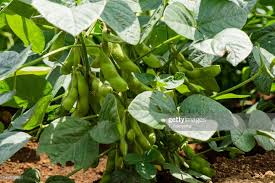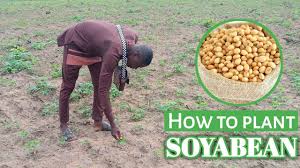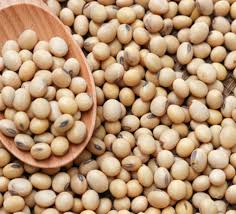![]()
If you’ve landed on this article page, you’re probably searching for a
good business idea—an idea that’s light on the pocket but heavy on
returns, promising both a fulfilling journey and potential profit.
|
How to Start Soya beans Farming in Nigeria
Soybean is among the major industrial and food crops grown in
every continent. The crop can be successfully grown in many
states in Nigeria using low agricultural input. Soybean
cultivation in Nigeria has expanded as a result of its nutritive
and economic importance and diverse domestic usage. IITA along
with partners has developed improved technologies for soybean
production.
Soyabeans is a broad acre crop. Soybeans is a key source of
protein for human and animals. Soybeans is widely used for the
production of animal feeds in Nigeria. Soybeans is also known as
a staple food in Nigeria.
Farmland or Site Selection; The site or farmland to be used for
soybeans farming should have good soil. There should also be a
good access road to the farmland for the easy evacuation of the
farm produce. The site should have abundant sunshine and
tropical climatic condition as soybeans can only grow well in
tropical conditions.
Climatic Requirements:
Soybeans is a tropical crop. It can only do well in areas that
are warm with abundant sunshine. Soybeans will not do well in
cold areas.
Soyabeans crop prefers a lot of sunlight. It also needs a warm
weather condition. The more the sun, the better the soybeans
yield.
Soil Suitable for Soybeans Farming: Soybeans prefers sandy loamy
soil as this the most suitable type of soil for its growth. The
soil should also have a well-draining capacity. Pure sandy soil
and clay soil do not make soybeans crop grow well.
The soil pH should be 5.0 – 7.5.
Soil that is too acidic should not be used for the
growing of soybeans. Soil that has a high alkaline content
should also be avoided.
Ploughing, harrowing and ridging should also be done. Several
rounds of ploughing may be done so that the soil will have a
good structure. Ridging may also be done, though this is not
compulsory.
Choosing the Soybeans
Variety to Plant: Hybrid soyabeans varieties are more productive
than the open pollinated varieties. Hybrid soyabeans varieties
also resist pests and diseases than open pollinated varieties.
Equipment to Use for Soybeans Farming: The following equipment
can be used for soybeans farming,
Tractors, Sprayers, Harrowers, Plough, Farm House, Power Tiller,
Cutlasses, Hoes, Earth Augers, Weeders etc.
Irrigation: Irrigation can be used to enhance the growing of
soybeans. It can also allow soyabeans farmers to grow their crop
in the dry season. The following are the types of irrigation
that can be used for soybeans farming in Nigeria: Drip
Irrigation, Sprinkler Irrigation, Furrow Irrigation, Spray Tube
Irrigation etc.
Planting of the Soybeans
Seeds: Soybeans seeds should be planted in 1 cm hole. The intra
row spacing of soybeans plant should be 5-10while the inter row
spacing should be 10cm – 15 cm.
The following are some soybeans varieties or seeds in Nigeria:
Variety: SC-SL01 (S1079/6/7), Variety: NCRISOY 2 (TGx 1989-19F),
Variety: NCRISOY 1 (TGx 1988-5F), Variety: TGx 1951-3F (TGx
1951-3F), Variety: TGx 1987-62F , Variety: TGx 1987-10F,
Variety: TGx 1904-6F ,Variety: TGx 1835-10E (TGx 1835-10E),
Variety: TGX-1448-2E (TGX-1448-2E)
Harvesting: Harvesting starts within 45 – 65 days after the
sowing of the seeds. Harvesting of matured soybeans pods in
large farms is usually done with the use of mechanized
harvesters. For small farms, cutlasses and sickles should be
used.
Post-Harvest: Soybeans
is usually sold in the open market after harvest. 100kg bags or
sacks are usually used to pack harvested soybeans grains.
Cost to Start a One Hectare Soybeans Farm in Nigeria
The cost to start a one hectare soybeans farm is detailed below:
Rent of one hectare farmland: ₦21,000
Clearing, Ploughing and Harrowing: ₦57,000
Seeds: ₦32,000
Planting: ₦10,000
Irrigation: ₦305,000 – ₦655,000 (Optional)
Fertilizers and Manure: ₦21,000 – ₦102,000 (Depending on soil
fertility)
Pesticides: ₦22,000
Others: ₦105,000
How many soybeans to plant per acre?
The optimal density per acre is approximately 100,000 plants, so
you should sow around 140,000 seeds per acre (as using a drill
results in a 75% average seed survival rate).
How Long Does It Take To Grow Soybeans?
They require anywhere from 100 to 130 days or more to complete
their full growth cycle. Because day length affects plant
development, longer days can delay flowering in short-day types
and lead them to grow in height and node number. Meanwhile,
shorter days accelerate flowering, even more so for
late-maturing types.
Seed Sourcing: Do not purchase seeds from the open market.
Always buy seeds from verified seed companies or the seed
producers nearest to you
Date of planting: Do not plant too early (before the
establishment of rain) because a prolonged dry spell after
planting may result in permanent wilting of the crop
Late planting, on the other hand, may expose the crop to attack
by some late-season pests and deprive the crop of sufficient
moisture if the rains stop early
Seed rate: About 50–70 kg (20–28 standard mudus) are required to
obtain a population of 444,444 plants/ha
Seed dressing: Treat
seeds with fungicides, such as Apron Plus, or Thiram, before
planting, at the rate of 1 sachet/8 kg of seeds for protection
against soil-borne fungal diseases
Plant spacing and
sowing, Sow soybean by hand, planter, or by drilling
Plant 3 to 4 seeds/hole at a spacing of 75 cm between rows and
10 cm between stands
Alternatively, drill seeds at 50–75 cm between rows and 5 cm
within rows
For the early maturing varieties, a spacing of 50 cm between
rows and 5–10 cm within rows
Do not sow seeds more than 2–5 cm deep
Fertilizer: A good
fertilizer recommendation for soybean production depends on a
good soil test
Under normal conditions, soybean should provide itself with
nitrogen through biological nitrogen fixation
Until nodulation occurs, the soybean plant depends on soil
nitrogen for growth
Apply a mixture of 2 – 3 bags of NPK 15:15:15 in addition to 2
bags of SSP fertilizers
Apply fertilizer on or not later than 7 days after planting
How to inoculate soybean
with NoduMax
Measure 10 kg of soybean
Place the amount in any container that will accommodate the
seeds
Prepare the sticker. Dissolve the content of the enclosed packet
of gum Arabic into 200 ml of warm water
Apply the sticker to 10 kg of soybean seeds and mix them until
uniformly coated
Add 100g of inoculants (1 sachet of NoduMax) to the seeds and
mix until seeds are uniformly covered
Cover the inoculated seeds with a cloth and put it under the
shade for the sticker to set
Plant the seeds on the same day that you inoculate them
Plant the inoculated seeds in a well-prepared moist soil and
cover immediately
Weeds control: A
properly timed weed control program can minimize their effects
Weed control in soybean could be achieved manually or with the
use of chemicals or by a combination of both methods
Manual weed control:
Carry out the first weeding at 2 weeks after planting and the
second at 5–6 weeks after planting
Chemical weed control:
The choice, however, depends on the predominant weed species and
the availability of the herbicide
Herbicides are available for pre-emergence or post-emergence
weed control
If the herbicide is applied at planting, one weeding may be
required at 5–6 weeks after planting
For pre-emergence weed control (Mix Glyphosate with
Pendimethalin or Dual Gold) in a ratio of 150mils for
Glyphosate, 200 – 250 mils for Pendimethalin and 150 – 200 mils
for Dual Gold all in 20 litre knapsack and spray within 24 hours
after sowing
For post emergence weed control (use Raptor or IRIS at 1.5 – 2
litres per hectare when the plants are 19 – 21 days after
planting
Insect’s pest control: Insect pests can be controlled with a
single spray of Cypermethrin + Dimethoate at flowering stage
Harvesting
At maturity, the pod is straw- coloured
Harvesting of soybean is recommended when about 85% of the pods
have turned brown for a non-shattering variety but 80% for
shattering varieties
The crop can be harvested when the seeds are at the hard-dough
stage
The seed moisture content is between 14 and 16%
Harvesting can be done with a cutlass, a hoe, sickles or
mechanized operation
Cut the mature plants at ground level
Stack them loosely on tarpaulin and allow them to dry in the
open for 2 weeks before threshing
Do not harvest by hand-pulling because this may deprive the soil
of nutrients added by the crop
Threshing soybean: Thresh manually or mechanically when the
plants are properly dried and as soon as possible
Storage: Dry to 12% moisture for storage of 6–12 months and to
10–11% for longer storage
Place bags of clean soybean on a rack in the cold room or in
ambient store
Soybean farming is highly profitable and offers excellent export
opportunities to Nigerian farmers. The crop is in high demand in
Asia, Europe, and America, with China being the world’s largest
soybean importer. In 2020, Nigeria exported 490 metric tons of
soybean worth $343,000, mostly to India and other Asian
countries. However, despite its potential for export, Nigeria’s
soybean production is still below its potential, with local
consumption accounting for a significant portion of the
production.
Soybean farming is a lucrative business opportunity that can
contribute to the economic growth of Nigeria and Africa. With
the right investment, training, and support, farmers can
maximize the potential of this crop to increase yields, create
jobs, and generate revenue from exports.
With proper planning, management, and investment, soybean
farming can be a viable and profitable business in Nigeria and
Africa, contributing to sustainable agricultural development and
food security for the region. Get our Practical Guide on How to start Soya Beans Farming business in Nigeria. This comprehensive guide will walk you through the fundamentals of starting and running a successful Soya Beans Farming Business in Nigeria, from initial planning to profitability. We’ll cover key factors like identifying in-demand niches, establishing a strong brand, marketing effectively, optimizing operations and delivering an exceptional student experience.
|







